What Is The Racetrack & What Are Call Bets In Roulette?
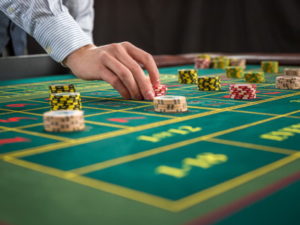 There are few casino games that boast the same level of popularity as roulette. Its simplicity is such that someone that has never played the game before can understand what it is that they’re supposed to do having spent no more than just a few moments studying the table.
There are few casino games that boast the same level of popularity as roulette. Its simplicity is such that someone that has never played the game before can understand what it is that they’re supposed to do having spent no more than just a few moments studying the table.
Choose your number or selection of the wheel that you think the ball will land on and place you’re money. In its simplest form, that is it. Indeed, part of the game’s appeal is that it allows you to place bets as simple or as complex as you’d like.
For those that tend to bet online more than in brick and mortar casinos, there tends to be another option that they can opt for: the racetrack. This is a part of the board that is like an elongated oval, with all of the numbers of the roulette wheel featured upon it but in random sections.
The middle of the racetrack offers bets called Voisins de Zero, whilst Tiers du Cylindre and Orphelins bets are also on offer. The racetrack also offers bettors the chance to place neighbour bets. The question is, what do all of these various things actually mean?
A Look At The Racetrack
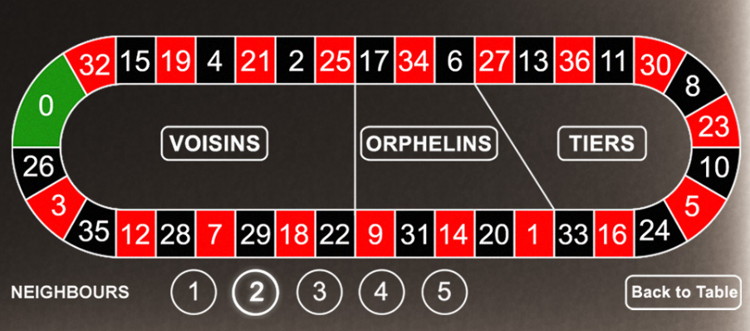
First things first, what is the racetrack? It is a version of the roulette table that looks a little bit like the shape of a racetrack, hence its name. An elongated oval, it offers punters the chance to place what are known as ‘call’ bets, which we’ll explain in more detail momentarily. The layout of the track allows the numbers to be displayed in a specific manner, rather than in the ascending order that a standard roulette table offers. To the uninitiated, this layout might seem to be completely bizarre, but there is actually method to the madness.
In essence, the racetrack is split into two: inside and outside. You place call bets on the inside, whilst the outside is where you’ll put neighbour bets. Should you start to look at the track at the number zero and then look to the right, the numbers are placed as follows:
0 – 32 – 15 – 19 – 4 – 21 – 2 – 25 – 17 – 34 – 6 – 27 – 13 – 36 – 11 – 30 – 8 – 23 – 10 – 5- 24 – 16 – 33 – 1 – 20 – 14 – 31 – 9 – 22 – 18 – 29 – 7 – 28 – 12 – 35 – 3 – 26
Most racetracks that you’ll find at roulette tables are the same, though there are some variations. Even when you’re looking at a different track layout, however, the likelihood is that the language used and the design of the track are the only things that are different. That is to say, the numbering system will still be in the same order, in terms of which numbers are next to which other ones. So it might say something like ‘Series 0/2/3’ rather than Voisins du Zero, for example, or Series 5/8 instead of Tiers du Cylindre. Irrespective of such changes, call bets and neighbours bets will work in the same way.
Neighbour Bets Explained
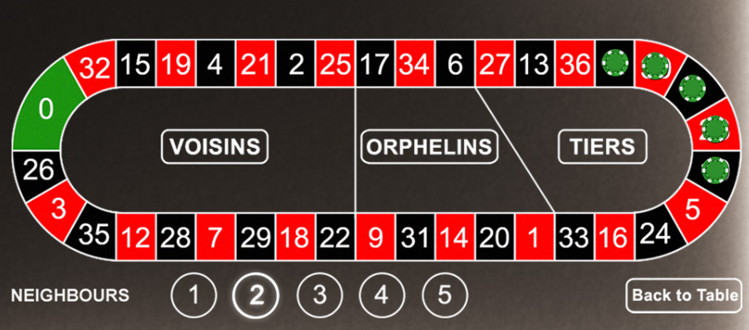
It is not uncommon for roulette players to place their chip in between several different options on the roulette board, allowing them to cover several possible outcomes at once. A neighbour bet is essentially doing the same thing, with a bet on one number covering five numbers that are all located close to one another. As an example, placing a bet on the number eight would also cover the ball landing on the two numbers before eight and the two numbers after it, making up the five numbers of your wager and giving you more options.
One thing to bear in mind is that a straight up neighbour bet is actually five individual bets. Much like an Each-Way bet on a horse race is a Single Win and a Single Place bet rolled into one and costing you twice the stake, so too is a neighbour bet the same as betting on each of the numbers individual. As a result, if your stake was £5 then you’d be betting £25 by placing a neighbour bet. Neighbour bets are what is known as a ‘call bet’. That means that you have to call out to the croupier and tell them the bet that you want to place.
An announcement from you along the lines of ‘Eight and the neighbours, £5 stake’ would be telling the croupier that you’re playing a bet of £25 on the five numbers that go along with eight and its neighbours. The key thing to remember here is that your stake will be multiplied by five, so tell the croupier your stake rather than the total amount of your bet. If you were to announce ‘Eight and the neighbours, £25’, thinking you were telling the croupier your total bet, you’d actually be liable for a wager of £125, so be careful.
As you have probably figured out, neighbour bets are based on the layout of the racetrack, not the traditional roulette table. Some roulette tables will allow punters to place as many as nine neighbour bets. That is to say, you could bet on eight and its nine neighbours in either direction for a total of 19 different wagers. You must remember, though, that each of these bets is a multiplier of your stake, so a £5 stake would result in a total wager of £95. The good news is that you would then be covering the best part of 50% of the table.
Another thing that you should know about neighbour bets is that they are only available on European and French roulette tables. American roulette doesn’t offer the option of placing neighbour bets, which, alongside the double zero, is part of the reason why it is a less popular form of the game in many places. The odds that you’ll get on neighbour bets are the same as straight up bets in European or French roulette, taking into account the increased number of bets that you’ll be placing. If you were to place a traditional neighbour bet that includes five numbers total, here’s how the maths works out:
- Stake unit is 5
- Winnings are 36
- Total profit is 31
- Probability is 5 in 37 or 1 in 7.4
- Payout odds are therefore 6.2 to 1
It is worth beating in mind that the payout odds are not the same as the probability because the House Edge is built into them. Straight-up wagers have a House Edge of 2.70% in both European and French roulette, meaning that a £5 bet on eight and its neighbours would be a £25 total wager. If the ball lands on one of your five numbers, you receive £175 plus your £5 stake back for total winnings of £180, but you also lost the £20 of the other four bets meaning your total profit is £160. This is obviously the same as if you’d placed five bets on five random numbers and one of them had won.</p>
The Call Bets

It is fair to say that neighbour bets are essentially just an easy way of covering five numbers in one go. A neighbour bet is a call bet because you have to tell the croupier that you’re placing it, if you’re in a bricks and mortar casino. Obviously the same isn’t true online, with the computer just working it all out for you without the need for your to shout at your screen, but they are still known as call bets.
There are also more specific call bets, which can be used to cover specific numbers on the roulette board that are in certain sections of the racetrack. This is what they are:
Voisins du Zero
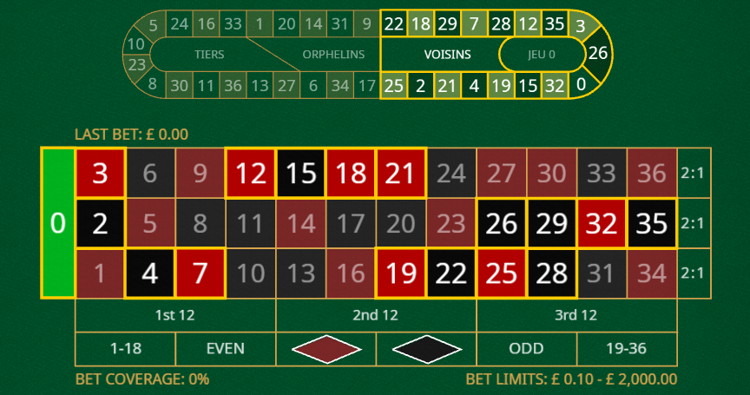
As you can probably tell, call bets come the original French version of roulette, which is why so many French phrases are used to explain them. Voisins du Zero translates as ‘neighbours of zero’, meaning that this bet covers the zero and the numbers that are closest to it. If you were to place a voisins du zero bet, you’re betting on 0, 32, 15, 19, 4, 21, 2, 25, 26, 3, 35, 12, 28, 7, 29, 18 and 22. You might notice that this is more than just five numbers and that is because this isn’t a neighbour bet. That also means that you’re not placing individual bets.
Instead, this wager is a combination of split bets, allowing you to cover the largest section of the roulette board offered by any of the call bets, thanks to three number wagers and corner betting. The bet breaks down as follows:
| Numbers Covered | Cost Per Unit | Payout Amount | Type Of Bet |
|---|---|---|---|
| 0, 2, 3 | 2 | 11/1 | Basket |
| 4, 7 | 1 | 17/1 | Split |
| 12, 15 | 1 | 17/1 | Split |
| 18, 21 | 1 | 17/1 | Split |
| 19, 22 | 1 | 17/1 | Split |
| 25, 26, 28, 29 | 2 | 8/1 | Corner |
| 32, 35 | 1 | 17/1 | Split |
This bet covers 17 numbers in total at a cost of nine units. That means that if your betting £5 per unit then your total wager will cost £45. The highest payout will come if the ball lands on 0, 2 or 3 and the chance of winning this overall bet stands at 45.9%.
Tiers du Cylindre
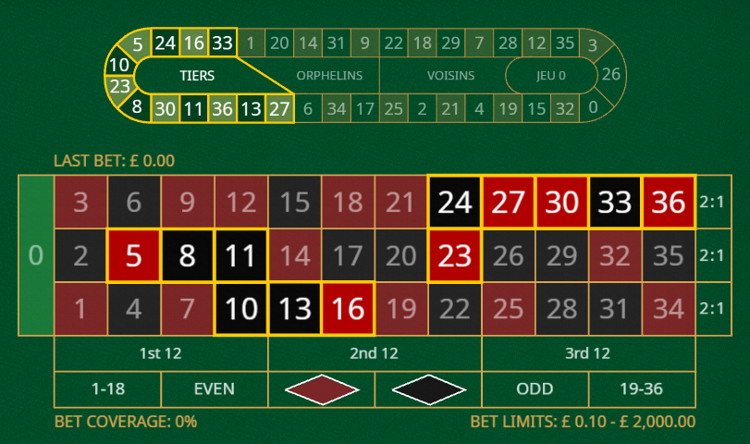
This French phrase translates roughly to ‘thirds of the wheel’. A Tiers du Cylindre bet covers the 12 numbers on the opposite side of the racetrack to the Voisins du Zero bet. The fact that it covers nearly one third of the table is where the wager got its name from, offering you the following bets:
| Numbers Covered | Cost Per Unit | Payout Amount | Type Of Bet |
|---|---|---|---|
| 5, 8 | 1 | 17/1 | Split |
| 10, 11 | 1 | 17/1 | Split |
| 13, 16 | 1 | 17/1 | Split |
| 23, 24 | 1 | 17/1 | Split |
| 27, 30 | 1 | 17/1 | Split |
| 33, 36 | 1 | 17/1 | Split |
Here you are placing 12 different bets, with a unit cost of six. In other words, a £5 stake would amount to a bet of £30, offering a 32.4% chance of winning. That is lower than. The Voisins du Zero bet, obviously, which is worth bearing in mind.
Orphelins
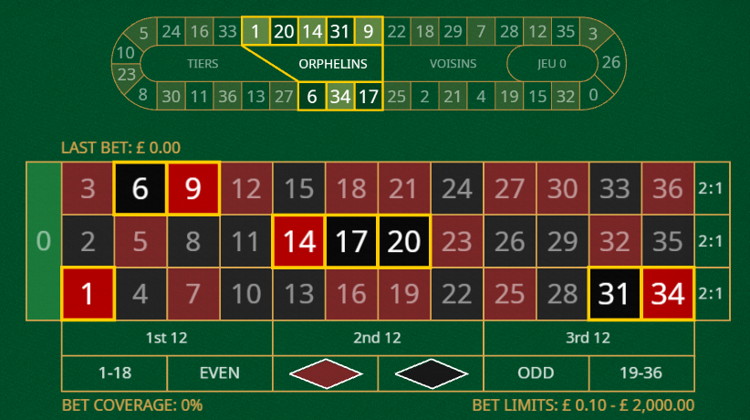
The translation of this word is ‘orphans’, which is an appropriate name as this wager covers the eight numbers that aren’t covered by either the Voisins du Zero or the Tiers du Cylindre bets. You get both a straight bet and a split, with the straight bet offering a higher payout. Here’s how the bet is broken down:
| Numbers Covered | Cost Per Unit | Payout Amount | Type Of Bet |
|---|---|---|---|
| 1 | 1 | 35/1 | Straight |
| 6, 9 | 1 | 17/1 | Split |
| 14, 17 | 1 | 17/1 | Split |
| 17, 20 | 1 | 17/1 | Split |
| 31, 34 | 1 | 17/1 | Split |
The number 17 appears twice in an Orphelins bet, which is the only number that overlaps in call bets. The chances of an Orphelins bet coming in stand at 21.6%, but it remains popular thanks to the 35/1 payout that comes with the ball landing on the number one.
Jue Zero
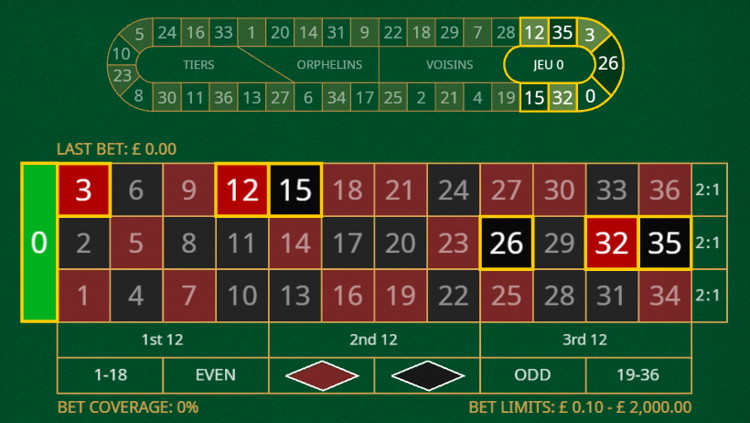
There is one other call bet that some casinos offer. Known as Jue Zero, or ‘zero game’, it is a shortened version of the Voisins du Zero wager and covers the following:
| Numbers Covered | Cost Per Unit | Payout Amount | Type Of Bet |
|---|---|---|---|
| 0, 3 | 1 | 17/1 | Split |
| 12, 15 | 1 | 17/1 | Split |
| 26 | 1 | 35/1 | Straight |
| 32, 35 | 1 | 17/1 | Split |
This bet covers seven numbers in total for a cost of four units, which would equal £20 if your stake is £5. The chances of winning this wager are the smallest of the lot, coming in at 18.9%, but you can still get a payout of 35/1 if the ball lands on 26, which is why it remains appealing for many people.
The Final Bet
There is one more call bet that you can make, which is the final bet. This wager type covers all of the possible bets that end in a digit of your choosing. Unlike the Voisins du Zero, Tiers du Cylindre and Orphelins bets, which are what are known as ‘fixed’ call bets because they cover specific numbers, the final bet is like the neighbour bet, insomuch as it is variable. That is to say, you can choose what your final number is going to be and the units that you’ll end up staking will be dictated by the number that you choose.
If you were to choose a final number of three, that would cover the ball landing on 3, 13, 23 and 33 – all options with the final number being three. A final bet on eight, meanwhile, would cover 8, 18 and 28, as there is no 38 on a roulette board. As a result, a bet on three would be four units and a bet on eight would be three units. The chances a final bet coming in are 10.8% if there are four options and 8.1% if there are three. Final bets don’t cover a continuous section of the wheel, but till promises an interesting way to place a wager.



